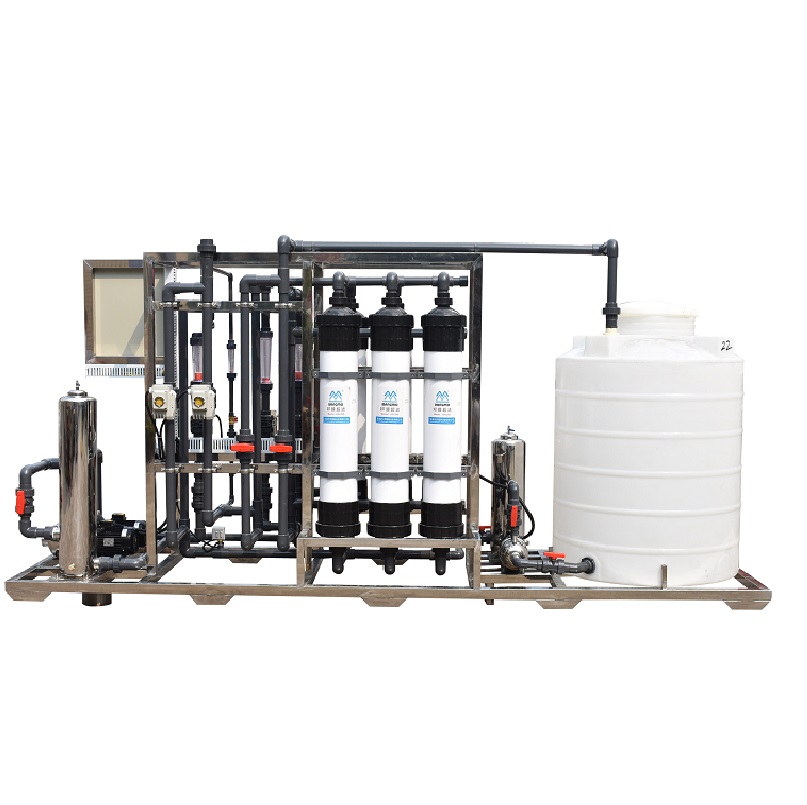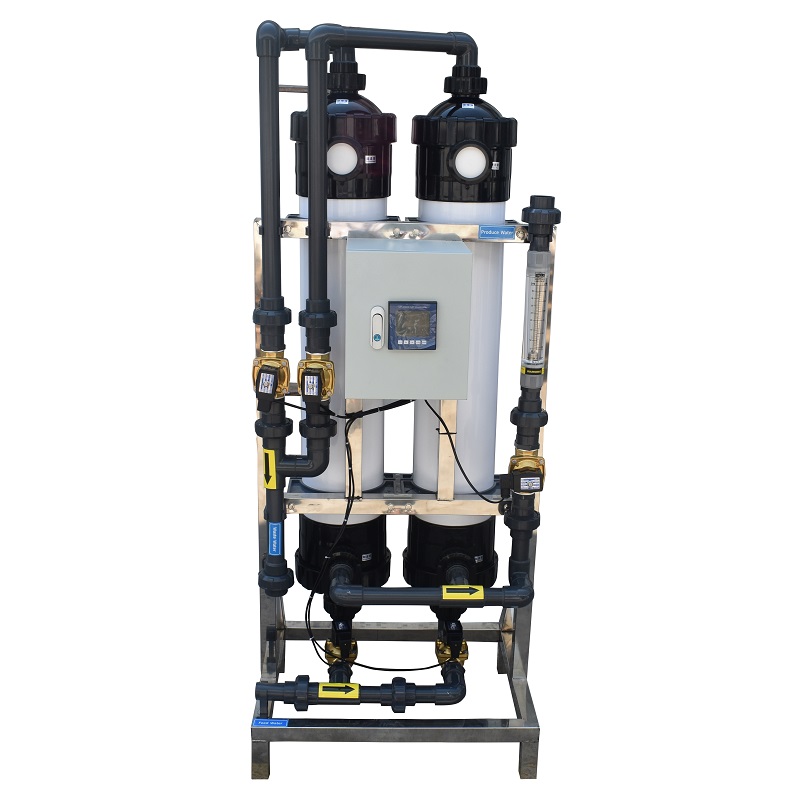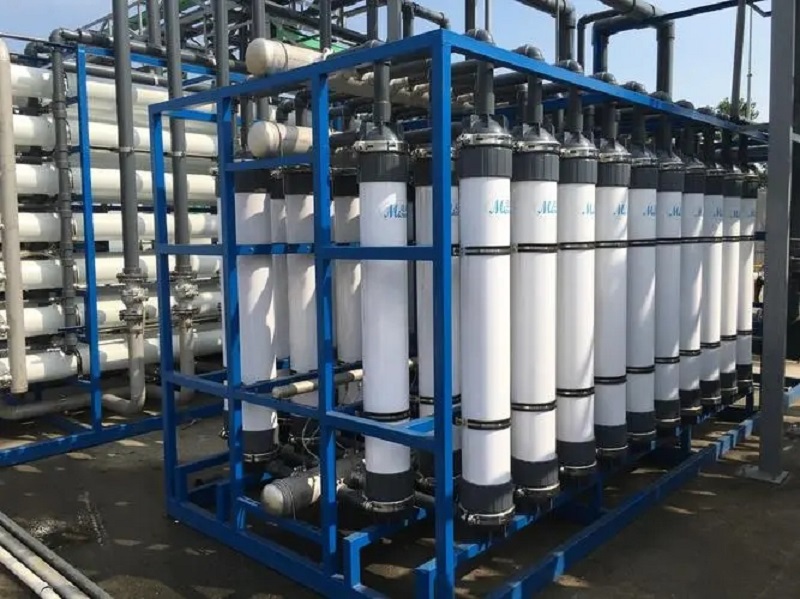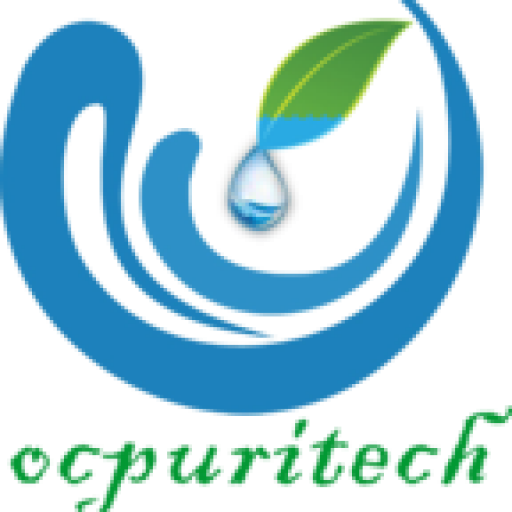What is ultrafiltration technology in water treatment?
In the process of ultrafiltration, the aqueous solution flows through the membrane surface under the push of pressure. The solvent (water) and small molecular solute smaller than the membrane pore permeate the membrane and become the purified solution (filtrate). The solute and solute group larger than the membrane pore are intercepted and discharged with the water flow to become the concentrated solution. The ultrafiltration process is dynamic filtration, and the separation is completed in the flow state. The solute is only deposited on the membrane surface, the ultrafiltration rate decreases to a certain extent and tends to balance, and can be recovered by cleaning.Ultrafiltration system is also closely related to reverse osmosis system. In many aspects, they are similar.
Ultrafiltration device, like reverse osmosis device, has plate type, tube type (internal pressure tube type and external pressure tube bundle type), roll type, hollow fiber type and other forms. Concentration polarization is a natural phenomenon in membrane separation process. How to minimize this phenomenon is one of the important topics of ultrafiltration technology.
The measures taken are: ① increase the water flow velocity on the membrane surface to reduce the thickness of the boundary layer and take away the trapped solute from the water in time; ② Take physical or chemical washing measures.

What is the principle of ultrafiltration technology?
The principle of ultrafiltration is not complicated. During ultrafiltration, due to the accumulation of trapped impurities on the membrane surface, a concentration polarization phenomenon will occur. When the solute concentration reaches a certain limit, the gel layer will be formed, resulting in a sharp decrease in the permeability of the membrane, which limits the application of ultrafiltration. Therefore, it is necessary to study through experiments to determine the best process and operating conditions, minimize the influence of concentration polarization, and make ultrafiltration a reliable reverse osmosis pretreatment method.
Ultrafiltration is a membrane separation technology (UF). It can purify, separate or concentrate the solution. Ultrafiltration is between microfiltration and nanofiltration, and there is no obvious boundary between them. Generally speaking, the pore diameter of ultrafiltration membrane is between 0.05 um – 1 nm and the operating pressure is 0.1 – 0.5 MPa. It is mainly used to intercept and remove macromolecular substances such as suspended solids, colloids, particles, bacteria and viruses in water. Ultrafiltration membrane can be divided into organic membrane and inorganic membrane according to membrane materials. According to the appearance of the membrane, it can be divided into: flat plate type, tube type, capillary type, hollow fiber type and porous type. At present, domestic ultrafiltration water purifiers are mainly hollow membranes.
The work of ultrafiltration membrane is mainly based on screening mechanism, and water purification is carried out by working pressure and pore size of membrane. Taking hollow fiber as an example, the water inlet mode can be divided into external pressure type: raw water enters from outside the membrane wire, and purified water is prepared from inside the membrane wire. On the contrary, it is internal pressure type. The working pressure of internal pressure type is lower than that of external pressure type. Ultrafiltration membrane has been widely used in many fields, such as advanced treatment of drinking water, concentration and separation of industrial ultrapure water and solution.
Advantages and disadvantages of ultrafiltration technology
The ultrafiltration equipment system has high recovery rate and excellent product quality, which can realize high-efficiency separation, purification and high multiple concentration of materials. The system is made of sanitary pipe valves, which are clean and sanitary on site and meet the requirements of GMP or FDA production specifications. The system has advanced process design, high degree of integration, compact structure, less floor area, simple operation and maintenance, and low labor intensity.
There is no phase change in the treatment process, which has no adverse effect on the components in the material, and the separation, purification and concentration process is always at room temperature. It is especially suitable for the treatment of heat sensitive substances, completely avoids the disadvantage of high temperature damaging bioactive substances, and effectively retains the bioactive substances and nutrients in the raw material system.
Ultrafiltration components shall be handled with care and protected. As ultrafiltration components are precision equipment, they shall be handled with care during use and installation, and shall not be damaged. If the components are out of service, wash them with clean water first, then add 0.5% formaldehyde aqueous solution for disinfection and sterilization, and seal them well. In winter, the components shall be subject to anti freezing treatment, otherwise the components may be scrapped.
The ultrafiltration equipment system has low energy consumption and short production cycle. Compared with the traditional process equipment, the equipment operation cost is low, which can effectively reduce the production cost and improve the economic benefits of the enterprise.
Ultrafiltration technology has the advantages of simple operation, low cost, no need to add any chemical reagent, especially the experimental conditions of ultrafiltration technology are mild, there is no phase change compared with evaporation and freeze-drying, and does not cause the change of temperature and pH, so it can prevent the denaturation, inactivation and autolysis of biological macromolecules. In the preparation technology of biological macromolecules, ultrafiltration is mainly used for desalination, dehydration and concentration of biological macromolecules. Ultrafiltration also has some limitations, it can not directly obtain dry powder preparation. For protein solution, generally only 10 ~ 50% concentration can be obtained.


Ultrafiltration Membrane
The key of ultrafiltration technology is membrane. There are various types and specifications of membranes, which can be selected according to the needs of work. Early membranes were isotropic homogeneous membranes, i.e. commonly used microporous films, with pore sizes of 0.05mm and 0.025mm. The relatively thin (about 1.0 mm) porous layer with a certain thickness (about 0.1 mm) and a relatively thin (about 1.0 mm) porous membrane are used as a support layer. The skin layer determines the selectivity of the membrane, while the sponge layer increases the mechanical strength. Because the skin layer is very thin, it has high efficiency, good permeability, large flow, and is not easy to be blocked by solute, resulting in the decrease of flow rate. Commonly used membranes are generally made of acetic acid fiber or nitric acid fiber or a mixture of the two. Recently, in order to meet the needs of sterilization in pharmaceutical and food industry, non fiber anisotropic membranes have been developed, such as polysulfone membrane, polysulfone amide membrane and polyacrylonitrile membrane. The membrane is stable at pH 1 ~ 14 and can work normally at 90 ℃. Ultrafiltration membrane is usually relatively stable. If used properly, it can be used continuously for 1 ~ 2 years. If not used temporarily, it can be soaked in 1% formaldehyde solution or 0.2% NaN3 for storage. The basic performance indexes of ultrafiltration membrane mainly include: water flux [cm3 / (cm2? H)]; Rejection rate (expressed as a percentage); Chemical and physical stability (including mechanical strength), etc.


There are three common operation modes in ultrafiltration process.
(1) Single stage intermittent operation: in the ultrafiltration process, in order to reduce the influence of concentration polarization, the membrane module must maintain a high feed liquid flow rate, but the membrane permeation flux is small, so the feed liquid must be circulated in the membrane module for many times to concentrate the feed liquid to the required degree, which is the most basic feature of the industrial filtration device. Batch operation is applicable to the treatment of products in laboratory or small-scale batch production.
(2) Single stage continuous operation: compared with intermittent operation, it is characterized by that the ultrafiltration process is always carried out at the concentration close to the concentrated solution, so the permeability and rejection rate are low. In order to overcome this disadvantage, multi-stage continuous operation can be adopted.
(3) Multi stage continuous operation: the concentration of circulating liquid in each section increases in turn, and the concentrated liquid is led out in the last section. Therefore, the feed liquid in the previous sections can be operated at a lower concentration. This continuous multi-stage operation is suitable for large-scale industrial production..
Application of ultrafiltration technology
As a membrane separation technology, ultrafiltration has been widely used in various fields of national economy, such as industrial production, medicine and health, environmental protection and people’s life. Although it can deal with a wide variety of objects, and people have different purposes, the role of ultrafiltration can be attributed to three functions: purification, separation and concentration.
(1) Application in industrial wastewater treatment
Industrial wastewater treatment is mainly used in: the treatment and application of sugar containing wastewater; Treatment of wastewater containing crude oil; Combined with bioreactor to treat various wastewater; Textile industry, dye and dyeing wastewater treatment and reuse; Treatment of papermaking wastewater; Treatment of radioactive wastewater, etc. For example, in the recovery of dyes from dyeing wastewater, during suspension tie dyeing in printing and dyeing plants, more vat dyes will be discharged from the reduction steamer in production, which is both pollution and waste. Using ultrafiltration technology and polysulfone and polysulfone amide ultrafiltration membrane, printing and dyeing wastewater can be treated without acid neutralization and cooling.
(2) Application in pharmaceutical industry
The main applications in pharmaceutical industry are: purification of antibiotics and interferon; Injection and water for injection to remove pyrogen; Plasma and biopolymer treatment; Separation, concentration and purification of proteins and enzymes; Refining and purification of Chinese herbal medicine. For example, the application of heat removal in the pharmaceutical industry.
(3) Application in water treatment
The applications of water treatment mainly include: pure water for electronic industry; Pretreatment of high purity water and water inlet of reverse osmosis components; Production of sterile water for beverages and cosmetics; Production of sterile and heat free raw water for pharmaceutical industry; For example, in the manufacture of mineral water, the water source must be groundwater, which will dissolve some inorganic salts when flowing underground. The combined process of ultrafiltration and microfiltration can be used to produce mineral water that meets the drinking water standard.
(4) Application in food fermentation industry
The main applications in food fermentation industry are: wine clarification and sterilization; Ripening soy sauce; Sterilization, clarification and decolorization of vinegar; Purification of fermentation broth; Clarification of fruit juice; Recovery of sugar juice and sugar liquid; Recovery of whey protein; Concentration of skimmed milk, etc.


